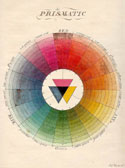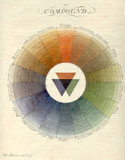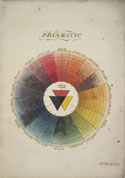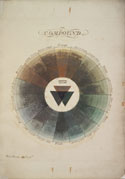Object Studies
Hand-Colored Engraving
What Are These Objects?
Two sets of color illustrations (plates) from Moses Harris's Natural System of Colours.1
1The plates are hand-colored. That is, the page was engraved with the segmented circle and its identification systems—the names and the numbers. The colors were added later, either before or after sale. reference
The plates of set A are in a private collection. Those of set B are in the Faber Birren Collection of Books on Color at Yale University. Web Link
^topHow Is the Color Made?
In the treatise from which these plates are taken, Moses Harris recommended the use of color tinctures to create the display of his color system. reference Watercolors applied in layers would allow subtle transitions between colors and shades in the circle. According to Harris's explanation, the primitive prismatic colors each use three parts of a single color (red, yellow, or blue) while the mediate prismatic colors are two-to-one combinations of the primaries, determined by their position on the circle. reference From this information, we can assume that each compartment received at least three washes or layers of color and perhaps as many as twenty, the number of shades or tones Harris designates within his circle. It is unlikely that Harris used as many as twenty color layers to create the deeper tones in these plates, however: It simply was not necessary. The narrowing size of each arc gives the perception of color darkening, and Harris may have taken advantage of that effect, just as he relied on the white paper surface to aid representation of the lighter shades. It is likely that Harris used some smaller number of color washes—three or six, perhaps—for each of the eighteen colors in each of the two circles.
Harris specified the colors to be used for his circle: vermilion, Kings yellow, and ultramarine. Perhaps to clarify the color terms of his circle, he linked each prismatic and each mediate color to a fruit or flower as well as a pigment. reference This is not, or is no longer, a foolproof identification method, as the color associations Harris invokes are not always similar in our perceptions. His choices to identify purple, for example—sheep's scabious (Jasione montana Web Link) and judas flower Web Link—have very different colors.2 Web Link
Condition
5
Harris's Color Equivalences
Red—Vermilion—Wild poppy
Yellow—Kings yellow—Butter flower, or meadow ranunculus
Blue—Ultramarine— Cornbottle flower
Orange—Red orpiment—Garden marigold
Green—Sap green—Leaves of the lime tree
Purple—Hairy sheeps-scabius—Flower of the common Judas-tree
Moses Harris, The Natural System of Colours (London, [1766]), 4.
The two versions of each plate together show some of the problems of color quality and color production. Comparison of the two sets of plates reveals variations in color and in condition for objects that were created according to one set of instructions and which may have been created by one person, even at the same time. The differences highlight some practical problems in the creation of such objects as these and in the information the objects provide.
The plates of set A appear to have only a few areas of darkening or of color loss, and no color is completely obscured. Larger portions of the plates of set B are discolored—so much so that it is difficult to determine what certain colors are or should be. The source of the damage to both sets of plates is uncertain, and so it is equally uncertain whether the color changes or distortions are due to the coloring materials used, to the techniques of application, or to coincidence. Stains are visible in roughly similar places in both prismatic tables and both compound tables. This suggests a connection to the coloring materials, as does the apparent lack of decay to the unpainted portions of the paper. The darkening of the colors could be due to an additive—a plasticizer such as sugar, perhaps—that turned brown with age or attracted mold or an insect. Or the coloring materials may have been poorly made.
Comparison of the colors of the plates suggests a second problem. In each plate, certain colors are almost indistinguishable from those of a neighboring segment, but each plate is different. In the compound colors of set A, olave green and green, and slate-purple and purple seem to be identically-colored pairs. In the same plate of set B, it is the orange-brown and orange, and the brown-purple and purple-brown that appear indistinguishable. The plates of prismatic colors do not appear to have this problem to the same degree as in the plates of the compound colors, but differences between each color is more pronounced. The purple-red of set B is less purple than that of set A, the green more blue. This suggests that some of the coloring materials may have changed—faded or darkened—since the creation of the objects. Whether these differences are original or are changes that have occurred in the past 130 years is unknown.
^topHow Are the Objects Used?
About the time of twilight in morning or evening, light a candle and set it on a table near the window, a sheet of white paper by it, so that the paper and the candle may be in parellel [sic] line with the window; then hold a piece of stick upright with one end on the paper, so that the candle by its light may throw the shadow of the stick on the paper, which will be of a very fine blue colour, this appearance arises from the orange colour which the flame of the candle casts all over the paper, except that part shadowed by the stick. Look into the prismatic system which will account for this, by informing the reader that blue is the contrast to orange.
Moses Harris, The Natural System of Colours (London, [1766]), 8.
According to Harris, his color system had both practical and philosophical uses. In his treatise, he noted an experiment in which a blue color arises from the orange of a candle flame. This experiment simultaneously confirms and is confirmed by his prismatic system, in which blue is opposite to orange. The experiment demonstrates that blue and orange combined make light; their placement in his color circle shows this too. His system thus demonstrates theories as easily as it supports practical applications.
Harris also emphasized the simplicity that would arise from the adoption and use of his color circles. These are common claims for color-classification or display systems. reference Here, simplification was related to the value that a stable nomenclature for colors has for color identification. Yet, however much we know of Harris's intentions, we know nothing about the contemporary use of these color circles.
^topNotes:
Note 1: Moses Harris, The Natural System of Colours, Wherein Is Displayed the Regular and Beautiful Order and Arrangement, Arising from the Three Primitives, Red, Blue, and Yellow, the Manner in Which Each Colour Is Formed, and its Composition, the Dependance They Have on Each Other, and by Their Harmonious Connections Are Produced the Teints, or Colours, of Every Object in the Creation, and Those Teints, tho' So Numerous as 660, Are All Comprised in Thirty Three Terms, Only (London, [1766]). back
Note 2: The Compact Edition of the Oxford English Dictionary, s.v. “scabious," and “sheep," def. 9. back




